2014 In Review and Top 20 + 10 Shakespeareances
More and Less: Now There's a Concept
Do the math: four, six, five, six, six, four, eight, one, and four. Do not add these numbers up. Rather, these figures, individually, are the total number of cast members we saw this year in full-length stagings of, respectively, William Shakespeare's Hamlet, Measure for Measure, Richard II, The Two Gentlemen of Verona, Cymbeline, A Midsummer Night's Dream, King Lear, Hamlet, and George Bernard Shaw's Saint Joan.
A five-person Richard II might be a training exercise, a one-man Hamlet might be a special event, and all the rest could be gimmicks except—well, do the math: in addition to the one-man reading of Hamlet, seven full-scale productions of Shakespeare plays had casts of eight or fewer. That's a trend. We are in the age where a cast of 15 seems crowded.
We can bemoan the state of the art in which actors are finding less and less employment, and they aren't the only ones: scenic designers, lighting directors, and even costumers are finding Shakespearean work shriveling, even as Shakespeare's works continue to be staged in overwhelming numbers. I genuinely feel for these theater professionals with real empathy: Not only is my son an actor, I'm a journalist, and a lot of my colleagues have been locked out of their chosen career even after 20 years or more of stellar work due to a myriad of social and financial trends.
Nevertheless, the dwindling numbers on stage and, in my experience, the increasing numbers in the seats represent a heartening trend in staging Shakespeare. This year, we saw 60 Shakespeare stage productions and one new film (out of a total of 83 plays we attended), and we're seeing an unmistakable shift in aesthete. More productions are eschewing the conceptual excesses that dominated the past 40 years—when directors imposed their thematic whims and dictatorial wills on Shakespeare's texts and our sensibilities—in favor of scaled-down, text-centric Shakespeare. This focus on what Shakespeare wrote and how he staged his plays is opening up a world of old discoveries to a new generation of audiences. That's another trend I see in the seats of theaters that are turning text-centric: their patronage is skewing younger.
That's not to say conceptual creativity is dead. We saw three productions this year that used Shakespeare to create new works exploring either inner turmoil of the modern state of minds (Enter Ophelia, distracted and Cry "Havoc!") or the political turmoil of the modern state (And to the Republic). Besides, simply presenting all of Hamlet through four actors while maintaining fealty to the text is conceptual creativity to the extreme. Notably, actors forming their own small companies to explore real Shakespeare and the vibrant potential of theater are responsible for these visionary stagings.
We saw some great acting again this year, and we heard a lot of great music, too. From Fiasco Theater Company's a capella chorales and bluegrass ditties to Brave Spirit's Celtic take on Billy Idol's "White Wedding," the music was as much a highlight as the Shakespeare. Meantime, the American Shakespeare Center, which always integrates good music into its productions, put together a touring troupe of actors matching in musical talent that of many arena concerts we attended this year (and we attend some 40 concerts per year).
This was the year for King Lear, for good, bad, and notoriously indifferent. Ira Glass's unfortunate tweet, "Shakespeare sucks," after seeing the Public's production in Central Park starring John Lithgow (whom Glass thought, individually, was great) at least brought welcome attention to one of Shakespeare's most timeless plays (despite Glass's contention that it has no modern relevance—he's flat-out wrong). Even before that episode, King Lear was dominating our theatrical landscape. We saw five productions of Lear (this year's leader was A Midsummer Night's Dream at six, but we saw 30 different Shakespeare plays this year, quite a variety). These were momentous productions, too, with Frank Langella in a lauded Chichester Festival production, my old fave Michael Pennington at the Theatre for a New Audience, and the aforementioned Lithgow playing the title role. King Lear is my favorite Shakespeare play, yet before this year I had never seen any production to rival the 1977 Royal Shakespeare Company version that hooked me on theater. Surely, some King Lear would top my annual Top 20 list.
Or would the American Shakespeare Center top it yet again, for the third year in a row? The little company in rural Staunton, Va., consistently stages some of the best Renaissance-era theater productions anywhere in the world (and we've been just about everywhere in the world of Shakespeare), and they do it in their replica Blackfriars Playhouse, one of the most beautiful play spaces anywhere in the world. In 2012 (Richard III) and 2013 (The Two Noble Kinsmen), they achieved transcendent theatrical moments for me (both are in the top five of my ongoing Top 40 Shakespeareances). I actually considered forbidding myself putting ASC at the top again no matter how good the production might be in order to share the spotlight. However, one, that would be dishonest and, two, ASC undercut that resolution in a hurry. Early on, one of its productions, again, scored as one of those elite theater moments in my life.
Yet, it was challenged, not once but twice. In fact, this was the most difficult year to select my number one because, from the end of the summer to the end of the year, three productions were scuffling over the top spot, each spending time at number one. That said, I want to reiterate here that while this list is ranked by my preference, it is not meant to denigrate productions landing near the bottom of the list: indeed, the difference in quality between Number 4 and number 54 on the Shakespearean list, and one through 22 on the non-Shakespeare list, is slim, all being shows I'd gladly sit through again. Also, another first this year, my wife, Sarah, made her debut on Shakespeareances.com writing the review of Taffety Punk's Bootleg Shakespeare production of Pericles because family business kept me from attending the play: thus, you will also need to check out her rankings, below, which are significantly different from mine.
So allow me to describe exactly how I arrive at my rankings. Upon writing my reviews, I place the production in this list: this establishes my in-the-moment attitude right after seeing the play. At the end of the year (yesterday, in fact), I revisit the whole list with a longer view and certain memories that prove more indelible than others. The list rearranges, a little and a lot: some plays move up or down significantly (one production fell 10 spots, another rose 14). If I need a tie-breaker (as was the case with the top three this year), I focus not on what made them great but what made them less great. Still stymied (as was the case with the top two this year, which had zero flaws), I turn to contextual merit: placing the performance in a long view of the play. Even that didn't settle the matter, for I went into one production expecting little and got a lot while the other I went in expecting a lot and got more.
Ultimately, I use the Our Town test. In Thornton Wilder's play, the recently deceased Emily is given a chance to relive a moment in her life. This turns out to be the final tragic nail in that play, but I use the notion simply as a device: at the point of death, if I'm given a chance to relive a Shakespeare or theater moment from the year, which would I choose? Let me be clear, this is only a litmus test for this list: if I'm allowed to relive one moment in my life, I guarantee it's not going to be a play (I can think of a dozen moments with Sarah I'd rather relive before anything else, and that's all I'll say about that). Anyway, I use this litmus throughout the rankings, and ultimately it distinguished this year's number one from number two.
I simply would have to see those arrows hitting the trunk again.
Top 20 Shakespeareances of 2014
- Cymbeline, Fiasco Theater, The Folger Theatre, Washington, D.C.
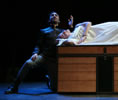 So much laudatory ink was expended on this production when it took New York by storm a couple of years ago, I was in an anticipatory fervor walking into the Folger Theatre to see it. I left the Folger afterward flying far higher than I had entered. The Fiasco Company—Jessie Austrian, Noah Brody, Paul L. Coffey, Andy Grotelueschen, Ben Steinfeld, and Emily Young—fully absorb the plays they stage, doing them with a fealty that belies the cuts necessary for using only six actors. They play their characters with deep inner truth, and Steinfeld and Young in particular have such a breadth of acting skills their collective performances would make the top five on this list. But for all its great acting, directing (Steinfeld and Brody), musical performances, and ensemble presentation, Cymbeline firmly lodges at the top of this list with the production's seventh performer, a trunk. Designed by Jacques Roy, it serves as the play's set and performs a variety of roles, most indelibly as a barricade in the battle, taking direct hits from enemy archers. Great Shakespeare, great theater, great fun, Fiasco's Cymbeline is simply astounding.
So much laudatory ink was expended on this production when it took New York by storm a couple of years ago, I was in an anticipatory fervor walking into the Folger Theatre to see it. I left the Folger afterward flying far higher than I had entered. The Fiasco Company—Jessie Austrian, Noah Brody, Paul L. Coffey, Andy Grotelueschen, Ben Steinfeld, and Emily Young—fully absorb the plays they stage, doing them with a fealty that belies the cuts necessary for using only six actors. They play their characters with deep inner truth, and Steinfeld and Young in particular have such a breadth of acting skills their collective performances would make the top five on this list. But for all its great acting, directing (Steinfeld and Brody), musical performances, and ensemble presentation, Cymbeline firmly lodges at the top of this list with the production's seventh performer, a trunk. Designed by Jacques Roy, it serves as the play's set and performs a variety of roles, most indelibly as a barricade in the battle, taking direct hits from enemy archers. Great Shakespeare, great theater, great fun, Fiasco's Cymbeline is simply astounding.
 Timon of Athens, American Shakespeare Center, Blackfriars Playhouse, Staunton, Va.
Timon of Athens, American Shakespeare Center, Blackfriars Playhouse, Staunton, Va.
How does Timon of Athens, an unfinished two-dimensional diatribe against all of mankind, become one of the best plays in the Shakespeare canon? When ASC's supremely talented and confident actors perform it at the Blackfriars Playhouse. Start with a brilliant cut of the text by Benjamin Curns, layer on the keenest of ensemble acting in which every member plays each of their multiple parts with detailed dedication, sprinkle on singular performances by Chris Johnston as the Poet and Josh Innerst as Apemantus, and top with René Thornton Jr. in the title role, massaging multiple dimensions out of the character and gripping us in his vicious cynicism and biting humor. Thornton's cursing prayer toward Athens that ended the production's first half inspired prolonged applause in the audience, yet it was just a prelude to his richly nuanced performance of the second half. Awesome and awe-inspiring. Perhaps this production ranks so high here out of astonishment than any other emotion; but, truly, when you leave a bare-bones, text-centric production of Timon of Athens thinking it is a better play than any Hamlet you've seen, you have just witnessed the height of acting.
 King Lear, Stratford Festival, Stratford, Ontario.
King Lear, Stratford Festival, Stratford, Ontario.
With King Lear being my favorite play and so many productions going on this year, the odds would seem pretty good that one of them would top this list. Ah, but after seeing such an all-around brilliant Royal Shakespeare Company production back in 1977, no presentation of this play has been totally satisfactory—until this one. Director Antoni Cimolino left only light yet revealing conceptual fingerprints on the play and hewed to the text to create a Lear that spoke directly from Shakespeare's mouth to us today. At the center of this solidly acted production was Colm Feore's Lear. He gave hints of Lear's senility in the first scene, induced the first tears with "Reason not the need," fell headlong into madness by the end of that speech, and in his scene with the blind Gloucester presented the most accurate portrayal of senility skirting lucidity I've ever seen on stage or screen. The final howls rattled our bowels, and his caressing the dead Cordelia shook our hearts. Great acting, brilliant directing, and Shakespeare's King Lear: that is as good as theater gets.
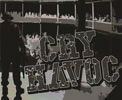 Cry "Havoc!" The Folger Theatre, Washington, D.C.
Cry "Havoc!" The Folger Theatre, Washington, D.C.
In his one-man play, Stephen Wolfert takes us from being a fetus to his present life as an Army vet who became an actor and copes with PTSD. His career change and the coping mechanism both came courtesy of Shakespeare, in whose plays Wolfert saw himself and found the words he needed to explain what was going on in his mind. The play's premise and Wolfert's astute Shakespearean choices of speeches to illustrate the passage and events of his own biography would have made worthy theater in and of themselves. But we end up living Wolfert's life through his characterizations and the way he pieces the narration together, constantly interrupting his chronology with the event that causes him ongoing horror, just as his own life is constantly interrupted by the eruption of that memory in his mind. Wolfert's aim is outreach, but the results are inreach, exemplified in the Vietnam vet watching the performance who, during the after-show talkback, opened up about his rages. That is transcendent theater.
 Pericles, American Shakespeare Center, Staunton, Va.
Pericles, American Shakespeare Center, Staunton, Va.
And here's yet another half-assed Shakespeare play proving irresistibly masterful in the hands of the ASC actors, this time directed by Jim Warren. This one works for the same reason Timon did: a company dedicated to text-centric presentations and a cast that is respectful of every Shakespeare and non-Shakespeare verse they speak (and a little surgical trimming helps, too). The problematic elements of the play's first half the actors put to good use in building their characters and creating dramatic arcs, especially Gregory Jon Phelps in the title role. In the play's second half, the acting turns Shakespeare's great writing into deeply funny, unerringly moving theater. René Thornton Jr. sets the tone and keeps it all light with his engaging Gower (merely accomplishing that illustrates incredible talent), and through it all are the colorful, impeccably detailed costumes of Jenny McNee. The production could have skated by on her work alone, but Warren and company also would have made this a stellar Pericles even if the cast wore street clothes.
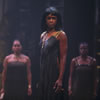 Antony and Cleopatra, Stratford Festival, Stratford, Ontario.
Antony and Cleopatra, Stratford Festival, Stratford, Ontario.
This is the way I've always felt Antony and Cleopatra should be presented, in an intimate theater with the audience close in on all sides (well, three sides in the Tom Patterson). And this is a Cleopatra, Yanna McIntosh, who mesmerized me in her every move, gesture, line-reading, and costume. She was the most sensuous Cleopatra I've ever seen and one of the most insightful, proving to be the smartest person in the whole Roman Empire. By going intimate, director Gary Griffin shows the insularity that causes as much conflict among the characters as military and political competition, and he plays up midlife crises as the real tragedy of Antony (a frustrated, torn Geraint Wyn Davies) and Cleopatra. They are Romeo and Juliet all grown up.
 A Midsummer Night's Dream and Julius Caesar, Shakespeare Theatre of New Jersey, F.M. Kirby Shakespeare Theatre, Madison, N.J.
A Midsummer Night's Dream and Julius Caesar, Shakespeare Theatre of New Jersey, F.M. Kirby Shakespeare Theatre, Madison, N.J.
This is both personal and professional. We attended a special, double-header public performance of these two productions of the Shakespeare LIVE! school tour troupe because son Jonathan Minton was a member of the company, playing Theseus/Oberon and Caesar. Seeing him was cool enough; watching him go places with Theseus and Oberon I've never seen before and nailing the egotistical Caesar haunted by lack of self-certainty was a point of tremendous pride. On top of all that, though, was the quality of the acting, costuming, and costume-changing in the fantastical Dream. With brilliant editing to get it down to under an hour, it featured a cast that tripled the parts of the Athenian lovers (Keystone Kops), Fairies (Seussian circus), and rude mechanicals (Charlie Chaplin) while Dean Linnard as Bottom died in many creative ways.
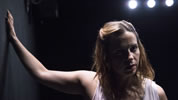 Enter Ophelia, distracted, Taffety Punk, Washington, D.C.
Enter Ophelia, distracted, Taffety Punk, Washington, D.C.
Kimberly Gilbert developed a one-woman show around a single stage direction in Hamlet, but as she collaborated with co-director Marcus Kyd and choreographer Erin F. Mitchell, the project took on a lives of its own. Gilbert and three other actress-dancers played Ophelia, and as we encounter other characters in the play (via voiceover) through her, we see how forces buffet her and, along with her own internal fragility, end up cracking her before she snaps into full-fledged madness. It is a vivid and accurate portrayal of mental disintegration, and it forces us to see the play, and Hamlet himself, in a different perspective.
 Measure for Measure, Fiasco Theater, New Victory Theater, New York, N.Y.
Measure for Measure, Fiasco Theater, New Victory Theater, New York, N.Y.
It's not the cleverness of six actors reimagining and editing the 23-character play; it's the imagination and insight into Shakespeare's original script and multiple multifaceted characters that make this production of Measure for Measure so satisfying. This troupe perfectly captures the play's three-pronged (spiritual, emotional, carnal) allegorical arc and maintains its moral ambiguity with sharp performances. And it's funny, too. Bringing singularly individual attributes to their parts, Fiasco's six members form a perfectly harmonic unit to produce sextetacular theater.
 Titus Andronicus, Faction of Fools, Gallaudet University, Washington, D.C.
Titus Andronicus, Faction of Fools, Gallaudet University, Washington, D.C.
I had been anticipating this commedia dell'arte interpretation of Titus Andronicus for almost a year, and it was everything I hoped for: a slapstick treatment of this overly tragic play with just enough of a serious vein to make us reflect on the fact that we are laughing at such violence. But because it's a Matthew Wilson-directed commedia production, it also brought acute insights into Shakespeare's characters and purposes, like the scenes where Titus and Marcus are so self-centered in their grief they ignore the real victim, Lavinia. Deaf actress Miranda Medugno as Lavinia created this production's most indelible memories, ranging from romantic ingenue to violated victim. In a Buster Keaton-quality deadpan manner she put up with all the idiotic mayhem around her, but in a moment alone, her eyes expressed deep hate at her assailants and the knowledge that her life was forever wracked.
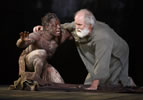 Chukwudi Iwuji as Edgar playing Poor Tom, King Lear, The Public's Free Shakespeare in the Park, Delacorte Theater, New York, N.Y.
Chukwudi Iwuji as Edgar playing Poor Tom, King Lear, The Public's Free Shakespeare in the Park, Delacorte Theater, New York, N.Y.
This production created buzz before (the casting of John Lithgow as Lear and Annette Bening as Goneril) and after (Ira Glass's infamous tweet). Overlooked in all the buzz was the performance not just of Chukwudi Iwuji playing Edgar but his Edgar playing Poor Tom as a mesmerizing specter. Our hearts broke when Edgar as Poor Tom saw the blind Gloucester and squeaked "bless thy sweet eyes, they bleed," and the tears welled up when Edgar looked forlornly at the body of Edmund (Eric Sheffer Stevens) whom he had killed but for whom he still held true brotherly love. Iwuji was erudite in his soliloquies, subtle in his disguises, and sharp in his interplay with Stevens, concluding with their six-weapon fight at the end. Bening certainly wasn't worth waiting all day to see, and though Lithgow was, Iwuji's Edgar was worth waiting a lifetime to experience.
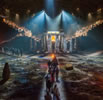 Macbeth, Park Avenue Armory, New York, N.Y.
Macbeth, Park Avenue Armory, New York, N.Y.
Grand spectacle and good Shakespeare. From the moment we entered onto the Scottish Highland heath—I'm sorry, it was actually the Park Avenue Armory drill hall—feeling like Harry Potter heading toward Hogwarts to the enthusiastic curtain call for Kenneth Branagh and Alex Kingston as the Macbeths, this was two hours of verse-perfect acting in a thrilling atmosphere. Directors Branagh and Rob Ashford took full advantage of the drill hall space to create a transformative set illustrating the tension between Christianity and pagan heritage and to stage a production that was both epic and intimate. At its center was the love story of Macbeth and his lady, a passion so intense they got swept away in the tide of misdirected opportunity. On any scale, this was spectacular Shakespeare.
 A Midsummer Night's Dream, Bristol Old Vic and Handspring Puppet Company, Kennedy Center's Eisenhower Theater, Washington, D.C.
A Midsummer Night's Dream, Bristol Old Vic and Handspring Puppet Company, Kennedy Center's Eisenhower Theater, Washington, D.C.
When you make eye-to-eye contact with Puck and become mesmerized with the sincerity in his gaze, even though you are really looking at a paint spray nozzle held above a basket, you know you have fallen under the spell of one powerful fairy. That's the magic that puppets in various forms bring to this production. They also bring unprecedented humor to the role of Bottom, whose ass really is the ass. All of that would be fun and noteworthy theater but just OK Shakespeare, if not for Tom Morris's insightful direction and clever way of using Shakespearean imagery to create the puppets.
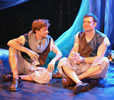 The Two Noble Kinsmen, Brave Spirits Theatre, Washington, D.C.
The Two Noble Kinsmen, Brave Spirits Theatre, Washington, D.C.
Staged in repertory with A Midsummer Night's Dream, this production, directed by Charlene V. Smith, leads off with Hippolyta (Jacqueline Chenault) singing Billy Idol's "White Wedding" (it works: trust me) and the opening dialogue from Dream between Theseus (Ian Blackwell Rogers) and his betrothed. Then enters the three widow queens and we are fully into a Kinsmen given formal treatment by Smith—until Palamon says, "I saw her first." With that one line the play trips into the absurd without becoming satirical. Thanks to the line readings of Willem Krumich as Palamon and David Mavricos as Arcite, their childish behavior is set against their ritualistic code of honor, and the play continues as a most intelligent comedy, with Jenna Berk's heart-rending Jailer's Daughter serving as tragic relief.
 The Comedy of Errors, Cincinnati Shakespeare Company, Cincinnati, Ohio.
The Comedy of Errors, Cincinnati Shakespeare Company, Cincinnati, Ohio.
Shakespeare drew on Ephesus's reputation for sorcery in setting his crazy Comedy of Errors there, and director Patrick Flick sets his version in an early 20th century traveling carnival to achieve the same effect. This could come off as entirely gimmicky, even given how effective Caitlin McWethy plays a half-man/half-woman Courtesan, how funny Brent Vimtrup plays the tent-revival-preaching snake oil salesmen Dr. Pinch, and how well Abby Rowold matched tarot cards to Shakespeare's verse in her portrayal of the Abbess as a fortune teller. However, the play maintains its dramatic tension along with its comic soul while the two sets of twins (Justin McCombs and Josh Katawick as the Antipholi; Jeremy Dubin and Paul Riopelle as show-stealing Dromios) maintain their frantic-antic dispositions to the end.
 Still Dreaming, Philomath Films.
Still Dreaming, Philomath Films.
This documentary chronicling the Lillian Booth Actors Home residents mounting a public production of A Midsummer Night's Dream could have been a Hallmark hanky event if not for the brutal honesty with which filmmakers Hank Rogerson and Jilann Spitzmiller delve into the parallels of the play's hallucinatory world and that of the cast members, some with cognitive disabilities. Its visual imagery, smart editing, and cast of natural characters give this movie new insights into Shakespeare's play while an unedited sequence of two women performing "You'll Never Walk Alone" becomes one of the truly special meteor moments of the year.
 Richard III, NextStop Theatre Company, Industrial Strength Theatre, Herndon, Va.
Richard III, NextStop Theatre Company, Industrial Strength Theatre, Herndon, Va.
Making Richard a Deaf man in a hearing world might seem a gimmick except that director Lindsey D. Snyder finds justification in the play's many allusions to communication in general and tongues in particular. To interpret Deaf actor Ethan Sinnott's signing for the audience, Snyder uses a staging device that ends up being thematic to the core: Buckingham (a deliciously smooth Sun King Davis) and then Catesby (Ben Lauer) interpret for the public interactions, adding new dimensions to the break between Richard and Buckingham; and a character called Shadow (Daniel Corey) speaks the soliloquies and ends up playing Richmond, resulting in a powerfully schizophrenic performance of Richard's final soliloquy.
 Hamlet, American Shakespeare Center, Staunton, Va.
Hamlet, American Shakespeare Center, Staunton, Va.
How a play so often done can seem so tantalizingly fresh is the brilliance of this American Shakespeare Center text-centric Method in Madness Tour production. The company digs deep into individual lines to unearth gems of interpretation, turning this familiar play into a passage of surprising twists. At the center is Patrick Earl's Hamlet, a troubled young man with superior intellect dealing with slings and arrows coming at him from so many different directions. While the psychological self-immolation of his soliloquies is heartbreaking, his madcap play-acting at madness is great fun.
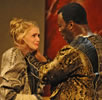 Othello, Riverside Theatre in the Park, Iowa City, Iowa.
Othello, Riverside Theatre in the Park, Iowa City, Iowa.
Desdemona appears on the upper stage as the play opens, waiting to elope with Othello. Kelly Gibson is noticeably young—she looks young, at least, and, more importantly, she plays Desdemona as young, and it brings a whole new perspective to this tragedy. It's more than just the treachery of Iago (an engaging Tim Budd) and the psychopathic deterioration of Othello (an all-in performance by Daver Morrison); it's the tragedy of the truly innocent Desdemona.
 The Tempest, Shakespeare Theatre Company, Washington, D.C.
The Tempest, Shakespeare Theatre Company, Washington, D.C.
Prospero may be old and tired, he may be young and tormented. But he is likely middle-aged and going through male menopause. We get the rightness of that reading in this production, with Geraint Wyn Davies flashing hot and cold in the person of Prospero. This is a surprisingly scaled-down production for Director Ethan McSweeny, who tends to be excessive in his visuals, as he relies on insightful interpretations of the text and brilliant performances from Rachel Mewbron as Miranda, Gregory Linington as Antonio, and Clifton Duncan as Caliban. The moment McSweeny does upscale things—when Prospero's pageant for the young lovers is played by giant puppets—is one of the most thrilling theater moments of the year.
Honorable Mentions:
Top 10 Non-Shakespearean Theatrical Moments of 2014
 Red Velvet, Tricycle Theatre Company, St. Ann's Warehouse, Brooklyn, N.Y.
Red Velvet, Tricycle Theatre Company, St. Ann's Warehouse, Brooklyn, N.Y.
Just watching the great 19th century Shakespearean actor Ira Aldridge playing Othello at London's Theatre Royal Covent Garden in 1833 would land this entry here. To be transported to that moment is part theater magic but mostly the acting talent of Adrian Lester playing Ira Aldridge playing Othello, and Charlotte Lucas playing Ellen Tree playing Desdemona. With great acting from the entire cast, Lolita Chakrabarti's new play provides a window into the racism, sexism, and Bardism of the mid-19th century and holds it up as a mirror to ongoing racism, sexism, and Bardism in the early 21st century.
 Saint Joan, Bedlam, Lynn Redgrave Theater, New York, N.Y.
Saint Joan, Bedlam, Lynn Redgrave Theater, New York, N.Y.
Is presenting George Bernard Shaw's masterpiece with only four actors and shifting theater configurations merely a stunt or effective theater? With this cast's talents (Andrus Nichols as Joan plus director Eric Tucker, Tom O'Keefe, and Stephan Wolfert as everybody else), the play starts off as great entertainment. By the end, we have become integrated into the play itself: We are the judges in Joan's inquisition, and after her death, Joan becomes one with us. Great acting of a great script is great theater. Factor in the brilliant application of a fluid play space and you get transdimensional theater.
 The Maid's Tragedy, American Shakespeare Center, Blackfriars Playhouse, Staunton, Va.
The Maid's Tragedy, American Shakespeare Center, Blackfriars Playhouse, Staunton, Va.
I loved the Francis Beaumont and John Fletcher script, and I enjoyed the series of one-on-one scenes in which the ASC Actors' Renaissance Season cast deliver deeply-rendered portrayals of characters and their psychosis. But, come on, this was the play in which Sarah Fallon, playing the duplicitous vixen Evadne, castrated the King right there on stage in the absolute most erotic murder I've ever seen. Even if the rest of the production wasn't as good as it was, that live theater moment would still land in the Top 10.
 The Importance of Being Earnest, Hudson Warehouse, Soldiers and Sailors Monument, New York, N.Y.
The Importance of Being Earnest, Hudson Warehouse, Soldiers and Sailors Monument, New York, N.Y.
Oscar Wilde could have written Algernon and Jack Worthing with, respectively, Jonathan Minton (my son) and George K. Wells in mind. They were as good in those roles as we expected, but what truly wowed us was a singularly ingenious portrayal of Gwendolen Fairfax by Amber Bogdewicz and the funniest Lady Bracknell we've ever seen, turned in by Linus Gelber. He played the formidable Aunt Augusta straight to the script: no hamming, no I'm-a-guy winking, just Queen Victoria sternness that was inherently amusing.
 Sex with Strangers, Signature Theatre, Arlington, Va.
Sex with Strangers, Signature Theatre, Arlington, Va.
Laura Eason's play crumples up and tosses aside all the clichéd trappings of most opposites-attract, older-woman-young-stud romantic comedies and in doing so delves into the values of literature and reputation in print versus online. Nevertheless, Luigi Sottile and Holly Twyford provided a lot of heat as the sex-having strangers. In particular, Twyford gave one of this year's most nuanced, honest, and courageous performances.
- Edward II, American Shakespeare Center, Staunton, Va.
 I give in. Christopher Marlowe—he's good. Though the caveat still must be that when the ASC does Marlowe, they do him good. Edward II is a ballsy play as Marlowe, writing during Elizabeth I's reign, took on the topics of homosexuality, class disparity, and divine right, and this Jim Warren–helmed production was equally ballsy in pushing these themes visually to the forefront. Anchoring the production were tour de force performances by René Thornton Jr. in the title role and Patrick Midgley as an audience-seducing Gaveston.
I give in. Christopher Marlowe—he's good. Though the caveat still must be that when the ASC does Marlowe, they do him good. Edward II is a ballsy play as Marlowe, writing during Elizabeth I's reign, took on the topics of homosexuality, class disparity, and divine right, and this Jim Warren–helmed production was equally ballsy in pushing these themes visually to the forefront. Anchoring the production were tour de force performances by René Thornton Jr. in the title role and Patrick Midgley as an audience-seducing Gaveston.
 Cyrano de Bergerac, American Shakespeare Center, Blackfriars Playhouse, Staunton, Va.
Cyrano de Bergerac, American Shakespeare Center, Blackfriars Playhouse, Staunton, Va.
John Harrell, with his exquisite poetical capabilities, his sublime comical tendencies, and his ever-present charm, was perfect for the part of Edmond Rostand's verse-speaking duelist with the big nose, Cyrano de Bergerac. Harrell went way beyond wry readings and winking poetics: he lived Cyrano's life and shared that life with us in an all-encompassing performance, brilliant in the execution and heartfelt in the portrayal.
- Mother Courage and Her Children, Stratford Festival, Stratford, Ontario.
 Bertolt Brecht offers up a dispassionate chronicle of the Thirty Years' War through the experiences of Mother Courage as she, one by one, loses her children. However, under Martha Henry's direction, the cast gives such nuanced performances we can see what the characters are feeling as well as thinking, including the otherwise enigmatic Mother Courage. Seana McKenna's titular performance alone was worth the price of admission.
Bertolt Brecht offers up a dispassionate chronicle of the Thirty Years' War through the experiences of Mother Courage as she, one by one, loses her children. However, under Martha Henry's direction, the cast gives such nuanced performances we can see what the characters are feeling as well as thinking, including the otherwise enigmatic Mother Courage. Seana McKenna's titular performance alone was worth the price of admission.
 Rosencrantz and Guildenstern Are Dead, The Acting Company, Guthrie Theater, Minneapolis, Minn.
Rosencrantz and Guildenstern Are Dead, The Acting Company, Guthrie Theater, Minneapolis, Minn.
With Grant Fletcher Prewitt and Ian Gould in the leads, the laughs kept coming, especially in two shared scenes with the play's progenitor, Hamlet, paired with this production in repertory. Nevertheless, the tragedy hit hard at the end. Bonus points for how this production ended up informing the company's staging of Hamlet.
 The Beaux' Stratagem, Stratford Festival, Stratford, Ontario.
The Beaux' Stratagem, Stratford Festival, Stratford, Ontario.
Though its subject matter is simultaneously dated and modern (taking on the disenfranchisement of second siblings and the disenfranchisement of wives in abusive marriages), this is a middling Restoration comedy by a middling writer, but it gets superior treatment under the direction of Antoni Cimolino and in an accomplished cast led by the Robin Williams–like Colm Feore as Archer and Lucy Peacock as the bedeviled and bedeviling Mrs. Sullen.
The rest of the Shakespeareances …
-
As You Like It, Shakespeare Theatre Company, Washington, D.C.
Set in the late 1920s with the banished lords appearing as newly minted hoboes, this Michael Attenborough-helmed production featured a nimble Rosalind in Zoë Waites literally ungirdling her inner id, a hunk of an Orlando in Andrew Veenstra who anchors his existence on the mere fact that a hot princess found him worthy to love, and Derek Smith as a dandy of a Jacques proving how simple, heartfelt deliveries of Shakespeare's famous speeches befit the times. - Macbeth, American Shakespeare Center, Blackfriars Playhouse, Staunton, Va.
Seeing this in the replication of Shakespeare's own indoor theater, we can see how Shakespeare himself may have intended to stage this play: as a psychological thriller. James Keegan's Macbeth was an ambitious yet honorable warrior navigating warring choices while Sarah Fallon was a shrewish Lady Macbeth who believes "hereafter" means tomorrow. The production's highlight, though, was Hecate (Chris Johnston) and the Weird Sisters (Gregory Jon Phelps, Patrick Midgley, and Jonathan Holtzman) with their playful malevolence and Jenny McNee's costumes of natural unnatural weirdness. - The Two Gentlemen of Verona, Fiasco Theater, The Folger Theatre, Washington, D.C.
Fiasco achieves a monumental accomplishment: turning The Two Gentlemen of Verona into one of Shakespeare's good plays. All of the players bring such genuine humanity to their roles that we see the geniality of Proteus (Noah Brody) before we see his tragic flaw of unbridled lust; we see the ego of Valentine (Zachary Fine) before we see his heroism; we see the manic moods of Julia (Jessie Austrian) as much as we see her fealty; we see the selfishness of Sylvia (Emily Young) while we see her unconditional caring; we see earnestness in Thurio (Paul L. Coffey) along with foolishness; and we see the humor of the Duke (Andy Grotelueschen) in tandem with his tyranny. - A Midsummer Night's Dream, Stratford Festival, Stratford, Ontario.
Using a gay wedding as its framework, Chris Abraham's production explored some gender-bending alterations to this play: Lysander was a woman, and the actors playing fairy royalty (Evan Buliung and Jonathan Goad) alternated the parts of Oberon and Titania night to night. The former was a gimmick that played nicely, the latter was getting the most out of great acting. But really, this whole exercise was about having fun, and the wedding framework kept that concept front and center. It also meant casting an obnoxious wedding guest as Demetrius, and Mike Shara stole the show with his performance. - Hamlet, Bedlam, Lynn Redgrave Theater, New York, N.Y.
This was not the greatest Hamlet we've seen but it was perhaps the most fun version of Shakespeare's play we might ever attend. Four actors take on every part (and all four take on Rosencrantz and Guildenstern) in a production that takes place among the audience. Director Eric Tucker is a master of making the most of a space and four talented players, but he's less interesting as the title character of Hamlet. Andrus Nichols, though, while revisiting the role of Gertrude she played so remarkably in the 2012 Shakespeare Forum production, adds a benchmark portrayal of Ophelia. We leave more in awe of the company's gumption than the play itself. - Henry IV, Part Two, Shakespeare Theatre Company, Sidney Harman Hall, Washington, D.C.
Juxtaposed with a disaster of a Part One, this fine rendering of Part Two might seem more exceptional than it really is, but, in fact, the production had a number of memory-searing moments: the presentation of Rumour as a tabloid-reading Ted van Griethuysen, who also turned in a delightful Shallow; the quick-witted repartee between Stacy Keach's Falstaff and Derrick Lee Weeden's Lord Chief Justice; and Hal, played more assuredly by Matthew Amendt in this second outing, bowing before the Lord Chief Justice during their conciliation scene. The silly Richard II voiceovers are still in our memories too, unfortunately. - The Two Gentlemen of Verona, Royal Shakespeare Company, Stratford-upon-Avon (RSC Live cinema broadcast).
Rather than fighting the play, Director Simon Godwin fully embraced it, imperfections and all, and we end up with an engaging comedy about imperfect young people coming of age—just like the playwright himself. In setting the play in modern Verona and Milan, the players bring modern context to their characters; thus, we hear 16th century mindsets that still run through society despite 21st century sensibilities tamping them down. Proteus (Mark Arends), Valentine (Michael Marcus), and Julia (Pearl Chanda) power the play's comic core, and Silvia (Sarah Macrae) truly is something special, a stylish woman of innate grace who can flirt and scrap with equal felicity. - Henry IV, Part One, Royal Shakespeare Company, Royal Shakespeare Theatre, Stratford-upon-Avon (RSC live cinema broadcast).
Antony Sher is solid as Falstaff, finding nuggets of true remorse in the character, and Jasper Britton is the most physically aggressive King Henry I've yet seen. But it is the reading of Hal that is so enticing here. Director Gregory Doran frames him—and Alex Hassell plays him—as a prince already planning how to maximize his popularity and political clout when he becomes king. His soliloquy is taken at face value, his interview with his father lays out of his long-term strategy, and his combat with Hotspur is that of a well-trained, confident prince against a skilled foe who totally misreads Hal. - Coriolanus, Donmar Warehouse, London, England (NT Live broadcast).
Even though Tom Hiddleston didn't satisfactorily portray the unmitigated jerk that Coriolanus must be—Hiddleston is just too charmingly nice, and his verse reading too smoothly musical—he is fascinating to watch precisely because he is so handsomely charming and verse perfect. But in this politically charged production—in which the tribunes, especially Helen Schlesinger as Sicinius, dominate the action—it is Hiddleston's youthful portrayal of Martius that most influences the aesthete as it skewers the ages of Aufidius (Hadley Fraser) as an audacious counterpart to Martius, and Virgilia (Birgitte Hjort Sørensen), who is every bit as tough as her mother-in-law. - As You Like It, Chesapeake Shakespeare Company, Patapsco Female Institute Historic Park, Ellicott City, Md.
A snowball fight, a group of minstrels playing "Stuck on You" every time a couple fell in love at first sight (except when it was Sylvius and Phoebe, whereupon she heaved an apple at the musicians), Corin and Touchstone fishing, Audrey dancing the lie seven times removed, and Jaques, here a schoolmarm type, using the audience and then Duke Senior as examples in her seven stages speech. This Patrick Kilpatrick–helmed production wasn't totally true to the text but it captured well the emotional textures of Shakespeare's comedy. - Twelfth Night, Synetic Theater, Arlington, Va.
How can you not love the Lindy hop, jitterbug, and Charleston, especially when a troupe of talented, acrobatic dancers are performing them with such infectious spirit? But this was much more than high-concept hoofin'. While this Silent Shakespeare production was not pure Shakespeare, its Bard roots come through in a moving allegorical arc of self-reflection and painful separation. Irini Tsikurishvili gets triple marks as Viola, Cesario, and choreographer, and Alex Mills as Sebastian is climbing up our ranks of favorite actors. - The Comedy of Errors, American Shakespeare Center, Blackfriars Playhouse, Staunton, Va.
Egeon (James Keegan) gives a straight, dramatic speech about his woeful life. Then the vaudevillian pair of Antipholus and Dromio of Syracuse enter, kicking off a succession of slapstick scenes. Instead of caricature clowning from Allison Glenzer as Adriana, she gives a heart-wrenching reading of the scorned woman, though with funny moments. And in the end you hear gasps in the audience when the Abbess reveals her true identity. As this Ralph Alan Cohen–directed production proved, Shakespeare has been playing you all along. - Hamlet, The Acting Company, Guthrie Theater, Minneapolis, Minn.
As this production got underway, it seemed so stuffy, as classically staged in Elizabethan costume and setting as you can imagine—except for those flashlights the guards used. Yet, the play was intriguingly acted. Then Rosencrantz entered flipping a coin, and this production's repertory pairing with Tom Stoppard's Rosencrantz and Guildenstern Are Dead cast Shakespeare's play in a whole new light: Elsinore as a theater and Hamlet as staged life. Yet it ultimately reached the state of realism for its audience. Brilliant. - A Midsummer Night's Dream, Baltimore Symphony Orchestra, The Music Center at Strathmore, Rockville, Md.
The premise delivered on its promise: rather than simply having an actor or four read Shakespeare lines as incidental narration to Felix Mendelssohn's incidental music, a troupe of talented Shakespearean actors (courtesy of the Folger) performed scenes from the play interspersed and in conjunction with passages of orchestral suite. Nevertheless, BSO music director Marin Alsop, conducting the orchestra and Baltimore Choral Arts Society, not only delivered Mendelssohn's sublime score but also scored the night's biggest laugh. - Henry IV, Part Two, Royal Shakespeare Company, Royal Shakespeare Theatre, Stratford-upon-Avon (RSC live cinema broadcast).
As a follow-on to RSC's Henry IV, Part One, with which it's sharing a repertory, this production disappointed. The business-like plotting Prince Hal that Alex Hassell played in Part One has disappeared, the ascension scenes are anticlimactic, and his conciliation with the Lord Chief Justice is cold. Nevertheless, this play belongs to Falstaff, and this production is all about Antony Sher playing Falstaff. Fully involved even when he's not speaking and nimbly working the fat knight's dialogues and diatribes, Sher gives us a Falstaff for the ages. - And to the Republic: The Roman Plays Reconstructed, The Guerrilla Shakespeare Project, Workshop Theatre, New York, N.Y.
Geordie Broadwater mixed and matched lines and passages from Julius Caesar, Antony and Cleopatra, and Coriolanus (and a bit of Othello) to create a story of American Vice President Brutus and Speaker of the House Cassius assassinating President Caesar and the subsequent fallout among DC's other power players, Chief of Staff Octavius, First Lady Cleopatra, Portia, and Antony, Caesar's brother who is having an affair with Cleopatra. - King Lear, Theatre for a New Audience, Polonsky Shakespeare Center, Brooklyn, N.Y.
I first saw Michael Pennington as Edgar in the 1977 RSC production, and to see him now playing Lear was beyond special, as was the portrayal of the family dynamics weaved into the sisters' performances (Goneril with bottled-up passions, a seething, cynical Regan, and still-his-baby-girl Cordelia). But a scene of the Fool hanging himself inserted by Director Arin Arbus redoubled on us to rob the climax of all its power, sabotaging what otherwise would have been number one on this list. I'm still ticked. - Hamlet…the Rest Is Silence, Synetic Theater, Arlington, Va.
This revival of Synetic's very first Silent Shakespeare production lacked the audacious stagings of subsequent Silent Shakespeares. However, simply doing Hamlet is audacious enough, and turning the psychologically meditative Hamlet, played by Alex Mills, into visual-only theater required the collective skills of the ensemble, which not only played the parts of Elsinore, a ship, the graveyard, and the stream in which Ophelia drowns, it also played the images passing through Hamlet's mind in his "To be" soliloquy. - Much Ado About Nothing, American Shakespeare Center, Staunton. Va.
Using a Seventies setting that's more distracting than contributing, the ASC touring troupe nevertheless stages a brilliantly interpreted and expertly acted version of Shakespeare's great rom com. Helmed by a onetime great Benedick, Benjamin Curns, and featuring another great Benedick in Patrick Earl, this Ado glides along with such an intent focus on Shakespeare's script that The Bard's storyline never slips into any credulity plot holes. And the music—goodness, this troupe boogies with the best of them. - As You Like It, New York Classical Theatre, Battery Park, New York, N.Y.
Battery Park is a perfect venue for a panoramic production of As You Like It, in which the play and audience move across the landscape, with the court scenes at Castle Clinton and the tree-covered lawns serving for Arden. Director Stephen Burdman assembled a dozen verse-skilled actors to play a dozen roles, including 12-year-old Jackson Demott Hill as old Adam (a visual riff on the Seven Ages of Man). - King Lear, Chichester Festival Theatre, BAM Harvey Theater, Brooklyn, N.Y.
Frank Langella was a powerful Lear for whom aging is a tragic flaw. However, while he played his howls as imploring the audience to join in, the production's real tragedy had already passed: hearing that Goneril and Regan, played by the gorgeous Catherine McCormack and gorgeous Lauren O'Neil, respectively, as intelligently wily but wicked women, were dead. Darn. - A Midsummer Night's Dream, Chesapeake Shakespeare Company, Baltimore. Md.
The highlight of this production was the new theater it played in, a renovated, 19th century bank building in downtown Baltimore with perfect sightlines, good acoustics, and beautiful aesthetics. The production featured subtly intriguing performances by the four lovers, funny Rude Mechanicals, Vince Eisenson's cat-like Puck, and Titania's cape turning into huge wings. - King John, Stratford Festival, Stratford, Ontario.
Tom McCamus's King John acting like a 14-year-old—the biggest brat in a playground full of brats speaking Shakespeare's grandiloquent verse—was one of the year's acting highlights. Alas, this "original practices" production ended up being tied down by its language rather than enlivened by it, and the long speeches outpaced the action like a tortoise beating a sleeping hare. - Henry VI, Parts One, Two, and Three, Hamlet Isn't Dead, New York, N.Y.
The opportunity to see all three plays individually is a Shakespeareances highlight. Director Robin Rightmyer cut a tad much: about half of Part One (not a great loss, as he hones the focus on the fomenting War of the Roses) and all of the Cade rebellion from Part Two. But he kept the bloody napkin scene intact, featuring intense acting by Sophia Blum as Margaret and son Jonathan Minton as York. - Much Ado About Nothing, The Public's Free Shakespeare in the Park, Delacorte Theater, New York, N.Y.
Director Jack O'Brien scattered in a bunch of weird stage business—all much ado about nothing—but Hamlish Linklater's insightfully balanced portrayal of Benedick paid off, as did casting Brian Stokes Mitchell as Don Pedro, from his fervently good-timing attitude to his joining Balthazar in a show-stopping rendition of "Sigh No More." - Rogue Shakespeare: Mary Baldwin MFA Performance Festival, Blackfriars Playhouse, Staunton, Va.
The invitation to attend this Festival is certainly a highlight of the year, so let's move on to the merits of the time spent—and it merits well. The one-hour Macbeth moved along at a quick clip and presented as an Appalachian storytelling circle. Richard II was staged with just five actors, and the mere fact that director Charlene V. Smith kept in the gage scene deserves praise and is indicative of the masterful way she handled the many parts among so few. The Festival's highlight, though, was Christopher Marlowe's Doctor Faustus, in which the three clowns (Julia Gayden Nelson as Wagner, Cyndi Kimmel as Robin, and Melissa Huggins as Rafe) improvised their scenes per their academic studies. - As You Like It, American Shakespeare Center, Blackfriars Playhouse, Staunton, Va.
Maybe when you do this play in original practice, its warts show. This production lacked the cohesion of a typical ASC Actors' Renaissance Season production, yet the players earned laughs, extricated almost entirely from the text rather than extraneous stage business. Sarah Fallon led the way as a silently commentating Celia and Gregory Jon Phelps made an endearingly bewildered Orlando. - Antony and Cleopatra, Royal Shakespeare Company, The Public, New York, N.Y.
In this scaled-down, Caribbean-set touring production, Director Tarell Alvin McCraney's heavy-handed edit of the script—particularly making Enobarbus a chorus and moving his famous barge speech to the front of the play to serve as a prologue—highlighted the frustration of Jonathan Cake's Antony stuck in his post-salad days while Samuel Collings's Octavius vies for relevance. - The Tempest, Olney Theatre Center, Olney, Md.
A set of umbrellas served as a fitting backdrop for a Tempest (both on stage and looming overhead) in which Craig Wallace plays a persistently bitter Prospero. Julie-Ann Elliott (Arial) and Leah Filley (Miranda) provided intriguing takes on their characters' place on Prospero's island (both are spiritedly rebellious), and Paul Morella turned Antonio into a villain of the caliber of Iachimo if not Iago. - The Comedy of Errors, Baltimore Shakespeare Factory, Boordy Vineyard, Hyde, Md.
Take an Actor Ensemble Experiment production in which the cast, sans director and designers, mount the play themselves with only five rehearsals, place it in a play space that they had not configured themselves and encountered for the first time only an hour before showtime, and you get an authentic sense of confusion the people of Ephesus are feeling in the play itself. - The Play's The Thing: An Evening of Hamlet with Ted van Griethuysen, Shakespeare Theatre Company, Washington, D.C.
To celebrate his 80th birthday, Ted van Griethuysen performed a stage reading of the entire First Folio/Second Quarto text. His stamina alone—his voice remained as commanding in the end as at the beginning—merits high praise, but his reprising his Polonius from the 1992 landmark STC production was one of this year's true treasures. - A Midsummer Night's Dream, Brave Spirits Theatre, Washington, D.C.
Running in repertory with The Two Noble Kinsmen, this production, well acted and with beautiful musical interludes, hit comic high notes with the rude mechanicals, particularly Willem Krumich as a macho Flute having to play Thisbe, Jenna Berk as a shy Snug finding her inner roar, and Zach Roberts as a whimsical Starveling playing Moon. - A Midsummer Night's Dream: A Chamber Play, Stratford Festival, Stratford, Ontario.
Using four excellent actors and a tiny stage in a small auditorium with walls and ceiling formed by junk (as if we were caught in a tornado), legendary director Peter Sellars's trimmed-down Dream explored the darker side of Shakespeare's play, revealing tormented and tormenting souls galore. It's a thought-provoking exercise and theatrics, but sitting through such trauma once is enough. - King Lear, Shakespeare's Globe, The Folger Theatre, Washington, D.C.
Blow winds. Rage, BLOW, BLOW DAMMIT!!! And that is Lear in his calmer moments. A promising staging, the Shakespeare's Globe eight-actor touring troupe, gets hijacked by a Lear (Joseph Marcell) who ramps up all his emotions to enlarged degrees. Every time he grabbed at his breaking heart, he resembled Fred Sanford ready to meet his departed Elizabeth. - Henry IV, Part One, Shakespeare Theatre Company, Sidney Harman Hall, Washington, D.C.
This one goes down forever as the non-preview preview. Though we had season subscription tickets to STC, we ended up assigned this play six days before Opening Night. Thus, the rote speeches, sloppy fight choreography, lack of chemistry, and desultory energy were this production's painful take-aways—along with director Michael Kahn's intruding on the action with Richard II voiceovers. - The Merry Wives of Windsor, Chesapeake Shakespeare Company, Howard County Center for the Arts Black Box Theatre, Ellicott City, Md.
We can at least imagine what could have been: a 1970s-set Merry Wives with a Marion Barry-like or Abscam-tainted Falstaff trying to scam suburban wives up the Potomac. Instead, this production was just one big send-up of the decade—the whole decade, from Aqualung to funk—and only a couple of characters found their Seventies' footing. I know—I was there. - Richard III, The Folger Theatre, Washington, D.C.
Director Robert Richmond was so infatuated with the discovery of Richard's grave in a parking lot, he made unceremonious burials his production's central motif, ignoring Shakespeare's obvious textual intent. Many more bizarre re-interpretations of the text made for a muddled mess of a production that itself should have been buried in a parking lot far from the Folger. - Julius Caesar, The Folger Theatre, Washington, D.C.
William Vaughan was great as Lucius, but that was not enough to save this self-indulgently directed, soulless, listless, zombie-filled production—which turned Shakespeare's timeless political masterpiece into an allegory of Sarajevo and the start of World War I—from cracking my top ten worst all-time Shakespeareances.
…and the rest of the non-Shakespeareances:
- The Great One-Man Commedia Epic, Faction of Fools, Washington, D.C.
Written, directed, choreographed, and performed by Matthew R. Wilson lived up to its name, an epic tale in which he played 12 traditional commedia dell'arte characters. And it was great. - Doctor Faustus, American Shakespeare Center, Staunton, Va.
Seldom do I leave a theater after seeing a Christopher Marlowe play saying, "Man, I'd love to see that again—right now." The slight-of-hand magic was "Whoa!" worthy, and Patrick Earl as Lucifer acts the hell out of just sitting on a table and watching Faustus fret. - Handle with Care, Westside Theatre (Downstairs), New York, N.Y.
Sheffield Chastain goes from good friend to one of the great acting talents we've seen as his performance of the bumbling package deliveryman in this Christmas story taking place in a small Appalachian motel room in which miracles take decades to come to fruition. - Sylvia, NextStop Theatre, Herndon, Va.
Shakespeare turns A.R. Gurney's play of anthropocentric humor into a deeply philosophical study in human communications. But what made this production so fun was Sherry Berg in the title role as a Labrador-standard poodle mix. - Driving Miss Daisy, Ford's Theatre, Washington, D.C.
Under Director Jennifer L. Nelson, the true quality of this play emerged, a series of vignettes that transpire like memory of Daisy (Nancy Robinette), Hoke (Craig Wallace), and Boolie (Ron Henegham) over the course of the epochal years of 1947–1973 in Atlanta. - The City of Conversation, Lincoln Center Theater at the Mitzi E. Newhouse, New York, N.Y.
Anthony Giardina's new play about an old-school liberal Democrat, Hester, going to war with her Reagan Republican daughter-in-law, Anna, while son Colin loses his testicles, figuratively, in the tussle succeeded on a clever script and vividly detailed characters. - Private Lives, Shakespeare Theatre Company, Lansburgh Theatre, Washington, D.C.
Director Marie Atken brought all her Coward experience to bear in a precise-paced, rhythmically delivered performance, and Bianco Amato and James Waterston gave achingly authentic portrayals of Amanda and Elyot and the love-hate chain that entwines them. - The Servant of Two Masters, American Shakespeare Center, Blackfriars Playhouse, Staunton, Va.
The ASC Actors' Renaissance Season company is not expert at commedia dell'arte, but the actors' well-honed individual and ensemble acting skills brought an intelligent multifaceted comic quality to the play. - Crimes of the Heart, Guthrie Theater, Minneapolis, Minn.
We saw a first-night preview performance, but the ensemble was tight, and though some of the characters proved grating in their excess, the hypocritical Chick, played by Sarah Agnew, is a genius creation by playwright Beth Henley. - All the Way, Oregon Shakespeare Festival/American Repertory Theater, Neil Simon Theatre, New York, N.Y.
Yes, Bryan Cranston won a Tony for his portrayal of LBJ (as did Robert Schenkkan's brilliant play), but we simply preferred the original cast at the Oregon Shakespeare Festival (Number One on our 2012 Non-Shakespearean list). - The 2nd Book of Ruth, The Laboratory Theater of Florida, Fort Myers, Fla.
Zalman Velvel's new play about an orthodox rabbi and the earthy, bubbly Ruth who wants to be converted to Judaism, grows in recollection of how well Velvel has drawn his characters and the layers of love and duty they experience. - Epicene, or the Silent Woman, American Shakespeare Center, Blackfriars Playhouse, Staunton, Va.
Ben Jonson's play is just stupidly mean and lands on one, single, saw-it-coming-miles-away joke. At least the ASC's Actors' Renaissance Company made it a fun theatrical outing. - The Importance of Being Earnest, Shakespeare Theatre Company, Lansburgh Theatre, Washington, D.C.
Overwhelming! The set, that is. Other than Vanessa Morosco playing Gwendolen Fairfax with buttoned-up yearning, though, this nostalgic rendering of a great play is little more than a forgotten figurine on the gorgeous end table.
Eric Minton
December 31, 2014
Comment: e-mail editorial@shakespeareances.com
Start a discussion in the Bardroom








 Find additional Shakespeareances
Find additional Shakespeareances